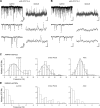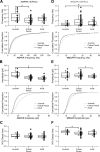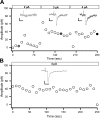Input-specific maturation of NMDAR-mediated transmission onto parvalbumin-expressing interneurons in layers 2/3 of the visual cortex
- PMID: 30303753
- PMCID: PMC6337035
- DOI: 10.1152/jn.00495.2018
Input-specific maturation of NMDAR-mediated transmission onto parvalbumin-expressing interneurons in layers 2/3 of the visual cortex
Abstract
Parvalbumin-expressing (PV) GABAergic interneurons regulate local circuit dynamics. In terms of the excitation driving PV interneuron activity, the N-methyl-d-aspartate receptor (NMDAR)-mediated component onto PV interneurons tends to be smaller than that onto pyramidal neurons but makes a significant contribution to their physiology and development. In the visual cortex, PV interneurons mature during the critical period. We hypothesize that during the critical period, the NMDAR-mediated signaling and functional properties of glutamatergic synapses onto PV interneurons are developmentally regulated. We therefore compared the α-amino-3-hydroxy-5-methyl-4-isoxazolepropionic acid receptor (AMPAR)- and NMDAR-mediated synaptic responses before (postnatal days 15-20, P15-P20), during (P25-P40), and after (P50-P60) the visual critical period. AMPAR miniature excitatory postsynaptic currents (mEPSCs) showed a developmental decrease in frequency, whereas NMDAR mEPSCs were absent or showed extremely low frequencies throughout development. For evoked responses, we consistently saw a NMDAR-mediated component, suggesting pre- or postsynaptic differences between evoked and spontaneous neurotransmission. Evoked responses showed input-specific developmental changes. For intralaminar inputs, the NMDAR-mediated component significantly decreased with development. This resulted in adult intralaminar inputs almost exclusively mediated by AMPARs, suited for the computation of synaptic inputs with precise timing, and likely having NMDAR-independent forms of plasticity. In contrast, interlaminar inputs maintained a stable NMDAR-mediated component throughout development but had a shift in the AMPAR paired-pulse ratio from depression to facilitation. Adult interlaminar inputs with facilitating AMPAR responses and a substantial NMDAR component would favor temporal integration of synaptic responses and could be modulated by NMDAR-dependent forms of plasticity. NEW & NOTEWORTHY We show for the first time input-specific developmental changes in the N-methyl-d-aspartate receptor component and short-term plasticity of the excitatory drive onto layers 2/3 parvalbumin-expressing (PV) interneurons in the visual cortex during the critical period. These developmental changes would lead to functionally distinct adult intralaminar and interlaminar glutamatergic inputs that would engage PV interneuron-mediated inhibition differently.
Keywords: AMPA receptors; NMDA receptors; PV interneurons.
Figures








Similar articles
-
Cell-Specific Regulation of N-Methyl-D-Aspartate Receptor Maturation by Mecp2 in Cortical Circuits.Biol Psychiatry. 2016 May 1;79(9):746-754. doi: 10.1016/j.biopsych.2015.05.018. Epub 2015 Jun 5. Biol Psychiatry. 2016. PMID: 26185009 Free PMC article.
-
Ketamine Administration During the Second Postnatal Week Alters Synaptic Properties of Fast-Spiking Interneurons in the Medial Prefrontal Cortex of Adult Mice.Cereb Cortex. 2016 Mar;26(3):1117-29. doi: 10.1093/cercor/bhu293. Epub 2014 Dec 4. Cereb Cortex. 2016. PMID: 25477370
-
Aberrant development of excitatory circuits to inhibitory neurons in the primary visual cortex after neonatal binocular enucleation.Sci Rep. 2021 Feb 4;11(1):3163. doi: 10.1038/s41598-021-82679-2. Sci Rep. 2021. PMID: 33542365 Free PMC article.
-
The role of glutamatergic inputs onto parvalbumin-positive interneurons: relevance for schizophrenia.Rev Neurosci. 2012 Jan 9;23(1):97-109. doi: 10.1515/revneuro-2011-0059. Rev Neurosci. 2012. PMID: 22718616 Free PMC article. Review.
-
Abnormal Gamma Oscillations in N-Methyl-D-Aspartate Receptor Hypofunction Models of Schizophrenia.Biol Psychiatry. 2016 May 1;79(9):716-726. doi: 10.1016/j.biopsych.2015.07.005. Epub 2015 Jul 17. Biol Psychiatry. 2016. PMID: 26281716 Free PMC article. Review.
Cited by
-
Unitary synaptic responses of parvalbumin interneurons evoked by excitatory neurons in the mouse barrel cortex.Cereb Cortex. 2023 Apr 25;33(9):5108-5121. doi: 10.1093/cercor/bhac403. Cereb Cortex. 2023. PMID: 36227216 Free PMC article.
-
Development, Diversity, and Death of MGE-Derived Cortical Interneurons.Int J Mol Sci. 2021 Aug 27;22(17):9297. doi: 10.3390/ijms22179297. Int J Mol Sci. 2021. PMID: 34502208 Free PMC article. Review.
-
Input-specific localization of NMDA receptor GluN2 subunits in thalamocortical neurons.bioRxiv [Preprint]. 2024 Aug 25:2024.08.23.607324. doi: 10.1101/2024.08.23.607324. bioRxiv. 2024. Update in: J Neurochem. 2025 Mar;169(3):e70049. doi: 10.1111/jnc.70049. PMID: 39229083 Free PMC article. Updated. Preprint.
-
Stability in the Face of Change: Lifelong Experience-Dependent Plasticity in the Sensory Cortex.Front Cell Neurosci. 2020 Apr 21;14:76. doi: 10.3389/fncel.2020.00076. eCollection 2020. Front Cell Neurosci. 2020. PMID: 32372915 Free PMC article.
-
Input-Specific Localization of NMDA Receptor GluN2 Subunits in Thalamocortical Neurons.J Neurochem. 2025 Mar;169(3):e70049. doi: 10.1111/jnc.70049. J Neurochem. 2025. PMID: 40123534 Free PMC article.
References
-
- Abrahamsson T, Chou CY, Li SY, Mancino A, Costa RP, Brock JA, Nuro E, Buchanan KA, Elgar D, Blackman AV, Tudor-Jones A, Oyrer J, Farmer WT, Murai KK, Sjöström PJ. Differential regulation of evoked and spontaneous release by presynaptic NMDA receptors. Neuron 96: 839–855.e5, 2017. doi:10.1016/j.neuron.2017.09.030. - DOI - PubMed
Publication types
MeSH terms
Substances
Grants and funding
LinkOut - more resources
Full Text Sources
Research Materials

